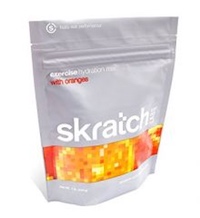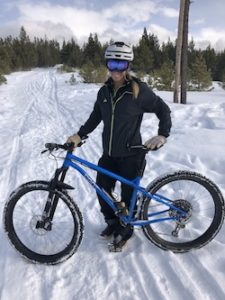Cool Weather Training Tips
By: Betsy Welch
Although March sounds spring-like, it doesn’t always feel like it. Snow is still a possibility, as is cold weather. However, March also means longer days and a natural transition toward becoming more active. Therefore, it’s a great time to start gearing up for your bike tour! Here are a few tips on how to make the most of the cool weather season, both indoors and out.
 Cool Weather Exercise Can Always Be A Challenge
Cool Weather Exercise Can Always Be A Challenge
But it doesn’t have to be an obstacle! With the right gear – and attitude – getting outside in early spring can help your body adapt in ways that training in warmer weather can’t. We’ll start with the basics:
1. Clothing – Layers are key
Springtime temperatures are notoriously fickle; we might start our day at a chilly 30 degrees only to find that the mercury has risen to 50 by midday. There’s nothing like having a good training day ruined by the wrong clothing choices. Dressing in layers guarantees that you won’t be stuck out in the cold. Our favorite next-to-skin layer is a thin merino wool layer. Merino wool is a powerhouse natural fiber! It is soft, moisture wicking, odor reducing, and temperature regulating, making it perfect for outdoor activities. Your merino wool layer should be followed by either a long sleeve fleece top or insulated vest, with the final layer being an insulated jacket if it’s extra cold or a shell to keep out the wind.
A good rule of thumb: you want to be slightly chilled when you head out to exercise, allowing your body to warm up without overheating. Wearing layers allows you to remove or unzip layers as your body heats up; this beats the alternative of not having enough on in the first place!
Experiment with layers on days when it’s not too cold. When you develop a system that works for you, the agony of deciding what to wear will never be an issue again!
2. Stay Dry
While staying warm is important, staying dry is crucial. Like we mentioned above, it might be cold when you start exercising, but remember that exercising will generate body heat and sweat even though it’s cold outside. Once moisture starts to accumulate in your clothes, it will begin cooling down your skin and your body temperature. If it’s really cold outside, it may even end up freezing close to your skin, which can lower your body temperature significantly and increase your risk of hypothermia. This is why we love wearing merino wool as our next-to-skin layer. Choose lightweight fabrics that wick moisture away from your body, keeping your skin dry and warm. Don’t overdress!
 3. Stay Hydrated
3. Stay Hydrated
Although our bodies don’t send thirst signals as strongly when the outside temperature is lower, staying hydrated is essential. It’s important to go into a workout well-hydrated and to drink during and after exercise, as well. Water or water mixed with an electrolyte solution is best. Don’t wait until you’re thirsty, either. If you tend to forget to drink when it’s cool out, set a timer and drink something every 30 – 45 minutes.
Pro tip: During the colder months, I even bring a thermos of hot tea or hot chocolate with me during my workout. Did you know that Hot Chocolate is also a great post workout recovery drink? It’s a perfect mix of carbohydrates and proteins for your post workout body and brain. -Kasia Martin
4. Stay Visible + Safe
The easiest way to stay safe when participating in any outdoor activity is to be visible. Although the days are longer, it still gets dark quickly this time of year. Wear clothing and shoes with reflective trim if you’re headed outside in early morning or evening light. If conditions don’t feel safe and motorists are having trouble, it’s probably not a good idea to go for a road ride. There are plenty of alternatives if the weather isn’t cooperating!
Now that you’re dressed and ready to go, here’s what to do!
 5. Snow Biking Is A Blast
5. Snow Biking Is A Blast
Have you thought about snow biking? Gaining popularity, some nordic centers or mountain bike groups have begun to groom trails for winter riding. The key to this activity is tire size and tire pressure – the wider the tire and the lower the pressure, the better! This allows you to travel over the snow, instead of sinking down into it. Your regular mountain bike will work if the trail is very hard packed and firm. If you have a local shop that rents snow bikes or fat tire bikes, those are even better! Remember to dress in layers and keep your hands and feet dry!
Pro Tip: My absolute favorite piece of winter riding equipment are my bar mitts & shoe covers! Bar mitts are insulated mitts that go over your handlebars with velcro, shielding your hands from wind & cold while allowing for full-finger mobility. Shoe covers act the same, sliding over your shoes to keep out the cold air. -Eric Martin
6. Try a workout
Simply getting comfortable on the bike is the most important thing early in the season, but if you like the added challenge of completing a workout, there are a few you can try. Intervals are the most common, and the easiest workout to start with is to warm-up for 15 minutes and then do 10 minutes of intervals – 30 seconds at a hard effort, then 30 seconds easy. X 10 minutes Cool-down for 15 minutes. Hill repeats are another common workout: find a hill and climb for 10 minutes. Mark your spot. Repeat 3 – 5 times. Cool down.
7. Go on a group ride
There is no better way to prepare for riding with a group than riding with a group! Your local bike shop is a great source for finding group rides. Facebook and other social media sites might have other options. Riding with others gives you access to other people’s experiences and advice and also helps you learn skills like riding in a pace line and basic mechanics. On your tour, you’ll frequently be riding with other people, so it’s a good idea to get some practice in!
8. Cross train
If you don’t feel like riding, or the weather prevents it, there are plenty of other activities to do outside when the weather is unpredictable. Running, walking, hiking, cross country, and uphill skiing are all great complementary activities to cycling. Remember, it’s doing the exercise that counts, not the type!
9. Ride a trainer or take a spin class
We know, we just taught you how to dress for the weather, but riding indoors is a great way to train in a controlled environment. Spin classes help take the effort out of planning a workout, and they force you beyond your comfort level to push hard. If you have access to an indoor trainer, there are hundreds of workouts online to choose from. Apps like Zwift allow you to complete virtual workouts or social group rides all from the comfort of your own home.


 Cool Weather Exercise Can Always Be A Challenge
Cool Weather Exercise Can Always Be A Challenge 3. Stay Hydrated
3. Stay Hydrated  5. Snow Biking Is A Blast
5. Snow Biking Is A Blast